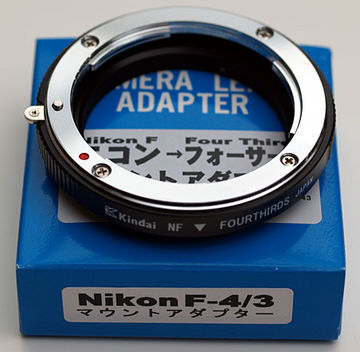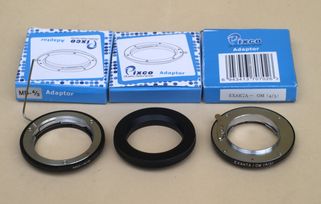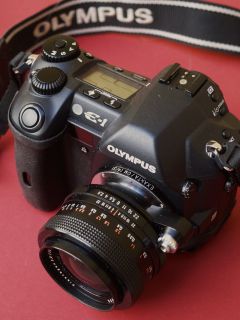Adapter (Fremdobjektive auf FT-System)
Olympus OM Adapter MA-1 (MF-1)
Zuiko-Objektive sind keine Fremdobjektive, deshalb sind die Informationen zu diesem Adapter von Olympus für Olympus-Objektive jetzt auf der Seite
Adapter (OM-Objektive auf FT- und µFT-System)
zu finden!!!
Richtig, genau die beiden von Dir gntennaen sind sehr Vertreter ihrer Art. Ffcr Portre4tfotografie ist jedoch auch das 45/2.8 aufgrund des nicht wirklich schf6nen Bokehs nur sehr begrenzt geeignet. Jetzt habe ich ein 50/1.4 an einer D7000 das sind wirklich Welten, sowohl in Bezug auf das cremigere Bokeh (wie man so schf6n sagt) als auch die Mf6glichkeit zur Freistellung.Randnotiz: Auch available light funktioniert so wesentlich besser. Mit Vollformat wird's dann richtig interessant.Das kommt dann spe4ter mal irgendwann. Erstmal den neuen Spadf ausreizen. Oder besser: beherrschen lernen.Nichtsdestotrotz hat mFT ohne Zweifel seine Berechtigung.
sonstige Fabrikate
U.S.-amerikanische und chinesische Fabrikate gibt es vor allem für M42 an Four Thirds. Einige chinesische Hersteller bieten ein breiteres Spektrum an Adaptern an, z. B. Cirrus (Angebot für Bajonette wie Kindai, zusätzlich Pentacon Six, Pentax 67, Mamiya 645, Hasselblad, T2) oder Rocks seine Pixco-Adapter-Serie (Exakta-Bajonett, Minolta MC/MD, M39) . Andere Hersteller offerieren Adapter mit eingebautem elektronischem Aktivator für die Fokussier-Kontroll-LED im Sucher der Kamera oder eines unangenehmen Piepstons zur Fokussierkontrolle (außer für E-1). Ein wahres Adapter-Dorado ist der Coma-Versand der mechanischen Werkstatt des Italieners Adriano Lolli, da muss man unter "Fotografia"/"Adattatori" gucken oder im englischsprachigen PDF-Katalog.
I bought my Sony A290 five monhts ago, and I've been using it regularly since. For starters, it must be said it's really easy to handle for most things. The usual complaint I've read about the grip being too small for large hands seems to be unfounded sure, you don't have a lot of legroom, but compared to a superzoom like the Panasonic FZ38 or the Fuji S1800, the Alpha has more than enough to spare. And the camera's as light as a feather, even when compared to a Rebel XTi, much less an EOS or a D40. Which, it must be said, makes it great to take quick shots (you can for instance sling it to capture a passing bird, whereas I'd be afraid to do as much with a heavier DSLR). Still, it's not that light, and so not really suited to one-handed shooting unless you have excellent pulse. How's the basics? The pictures have great quality, and capture faithfully what the eye sees. Depth of field, at narrow apertures, is quite good, and the 18mm setting of the lens is a monster for landscapes. Speaking of the kit lens, it has almost no bokeh except when stressed to great lengths, so keep that in mind if you're thinking of portraiture (but when it does come out, it's quite pleasing). On the other hand, pictures of moving subjects are this camera's and lens' strongest point; the SteadyShot function can correct gross shake, but keep in mind it's slow to recharge! This is not necessarily bad, as you can, for instance, take four frames in a sequence let's say of a passing car: the first will be very sharp, while the two next ones will exhibit amazing panning, and the fourth will be stable again. Also, the SteadyShot function is built into the camera, so you can use it with older lenses (this is a HUGE benefit). By the way, if you're looking for a camera to use always on full auto, then I'd recommend you to get something else, as it doesn't have the brains to produce good results except in fairly normal conditions (the auto-focus is especially lame). Why the four stars? Well, I have a few gripes with the A290. The first and most blatant is NOISE. This is NOT a camera for low-light exposures, due to a combination of noisy images, terrible quality at higher ISO, and a flash that I swear consumes like 10% of the battery each time it's used! If you want mostly daylight pics, like me, then you'll find it to be excellent quality for the money. But otherwise, it might be wise to invest in another device. The second one is the method to change aperture on full-manual (I only use this mode, BTW, so it might not apply to you) it requires one to press the AV button, which is awkwardly located, and can cause mistakes even after monhts of practice. The third one is the menu; while very user-friendly, it's sometimes a tad too simple. Not that I use it too much, but still. Also, the camera doesn't revert to instantaneous shooting after shooting with the timer, which will cause you some mild annoyance. Finally, the focusing ring is sloppy and a bit imprecise but this is a problem of the kit lens, after all. The good things? Well, it's the cheapest DSLR in the market, I think. It has no superfluous or otherwise gizmo-like functions to interfere with shooting. The few it has are well-accomplished and useful (shooting B&W with the Alpha is simply wonderful!). It's fast, light, and very simple to wield. For nature and wildlife photography, the colors and sharpness that it achieves are stupendous, a step above any compact. The full-manual mode is very intuitive and can be mastered in a few days. It's automatic white balance is excellent. And the batteries last quite a while, as long as you don't use it's interrogation device err, flash (it's quite powerful). In this regard, and perhaps better, it consumes almost no power when left on and in standby (I once left mine two days in this state, and it still had some power left!) so you can keep it always ready to shoot. The veredict? The Sony Alpha 290 is an excellent camera for those seriously interested in photography, but are just starting, and also for those who want the quality and capabilities of a DSLR at a reduced price. I'd especially recommend it to wildlife and nature enthusiasts as long as you don't require low-light pictures, or extreme zoom, then it'll do nicely for you. The Sony lenses are good, and growing in availability, so this is a waning concern. Also, a lot of accessories are popping out for the Alpha range. As a camera to learn the ins and outs of manual, SLR photography, you'd be hard-pressed to find one as user-friendly and cheap as this one. All in all, I'm very satisfied with my purchase, and I wouldn't hesitate to recommend this camera to someone else, nor would I doubt to purchase another Alpha range DSLR.
Referenzen
[1] Minolta MC/MD-Adapter für Four Thirds werden besonders für die E-1 empfohlen, bei anderen Olympus-DSLR können Manipulationen an FT-Bajonett oder an den Objektiven nötig sein, die nur mit sicherem handwerklichem Geschick zu bewältigen sind, falls der Blendenauslösehebel des Objektivs um ein paar Zehntel-mm zu lang ist. Cameraquest ist neben Kindai und Novoflex Anbieter und möglicherweise auch Erfinder dieses Adapters (siehe http://www.rokkorfiles.com/olympus.htm). Auch chinesische Fabrikate gibt es für diese Adapter, z.B. Cirrus. Der Minolta-MD-Adapter ist eine besonders grenzwertige Konstruktion. Entweder sind es geringste Fertigungsabweichungen von den Optimalmaßen beim Objektiv-Bajonett oder beim Adapter, oder es ist die geringe Verwindungssteife durch die geringe Materialstärke des Adapters, was dazu führen kann, dass beim Festschrauben des Objektivs im Adapter Verkantungen auftreten, denn im originalen Minolta-Kamera-Bajonett erfolgt die Fixierung ja auch nicht durch Festschrauben. Im Extremfall hat das auch optische Auswirkungen: Beim Einsetzen des Objektivs wird dann Unendlich noch scharf angezeigt, nach dem Festschrauben aber nur noch das halbe Bild. Der Adapter empfiehlt sich also nur für Besitzer mehrerer Minolta-MF-Objektive, bei einem ist das Risiko hoch, dass gerade damit Probleme auftreten. Ein extra-billiges 11-€-MD/MC-Adapter-Fabrikat kann zwar ein Objektiv möglicherweise korrekt adaptieren, der eine oder andere wird aber mit Material- und/oder Fertigungs-Qualitäts nicht ganz zufrieden sein, z.B. wenn sich das Objektiv nicht mehr mitsamt Adapter leicht lösen lässt.
Hier ist das Micro Four Thirds-System zu empfehlen, welches durch das kleinere Auflagemaß mehr Luft für die Adaption lässt - siehe hierzu den detaillierten Artikel zur Adaption von Fremdobjektiven auf MFT.
Interne Verweise
- Adapter (allgemeine Informationen zu Adaptern)
- Adapter (Fremdobjektive auf OM-System)
- Adapter (OM-Objektive auf Nicht-Olympus-DSLR)
- Adapter (FT-Objektive auf µFT-System)
- Adapter (OM-Objektive auf FT- und µFT-System)
- Adapter (Fremdobjektive auf µFT-System)
- Empfehlenswerte Objektive zur Adaption
- Auflagemaß
- Abbildungsfehler
- Cropfaktor



